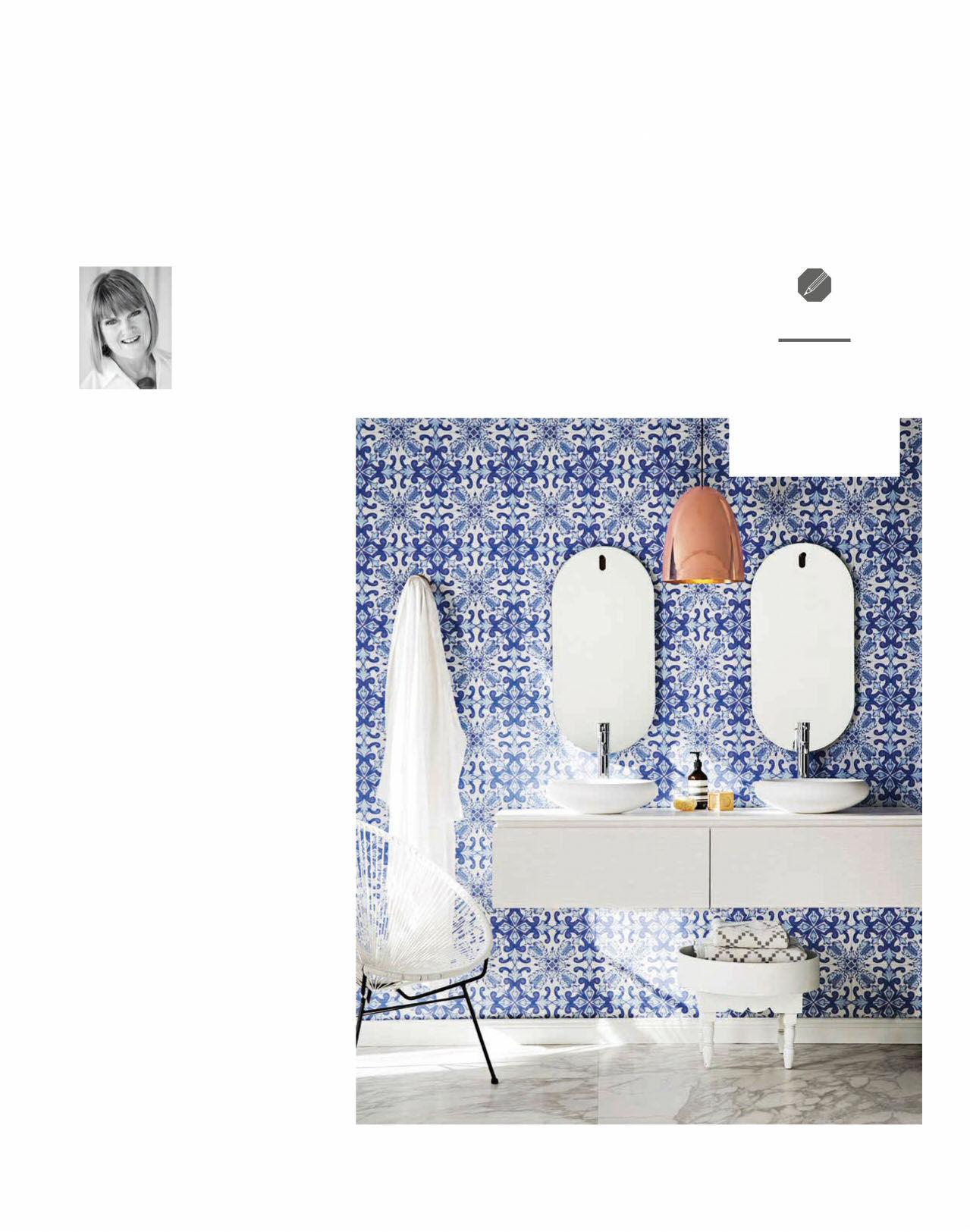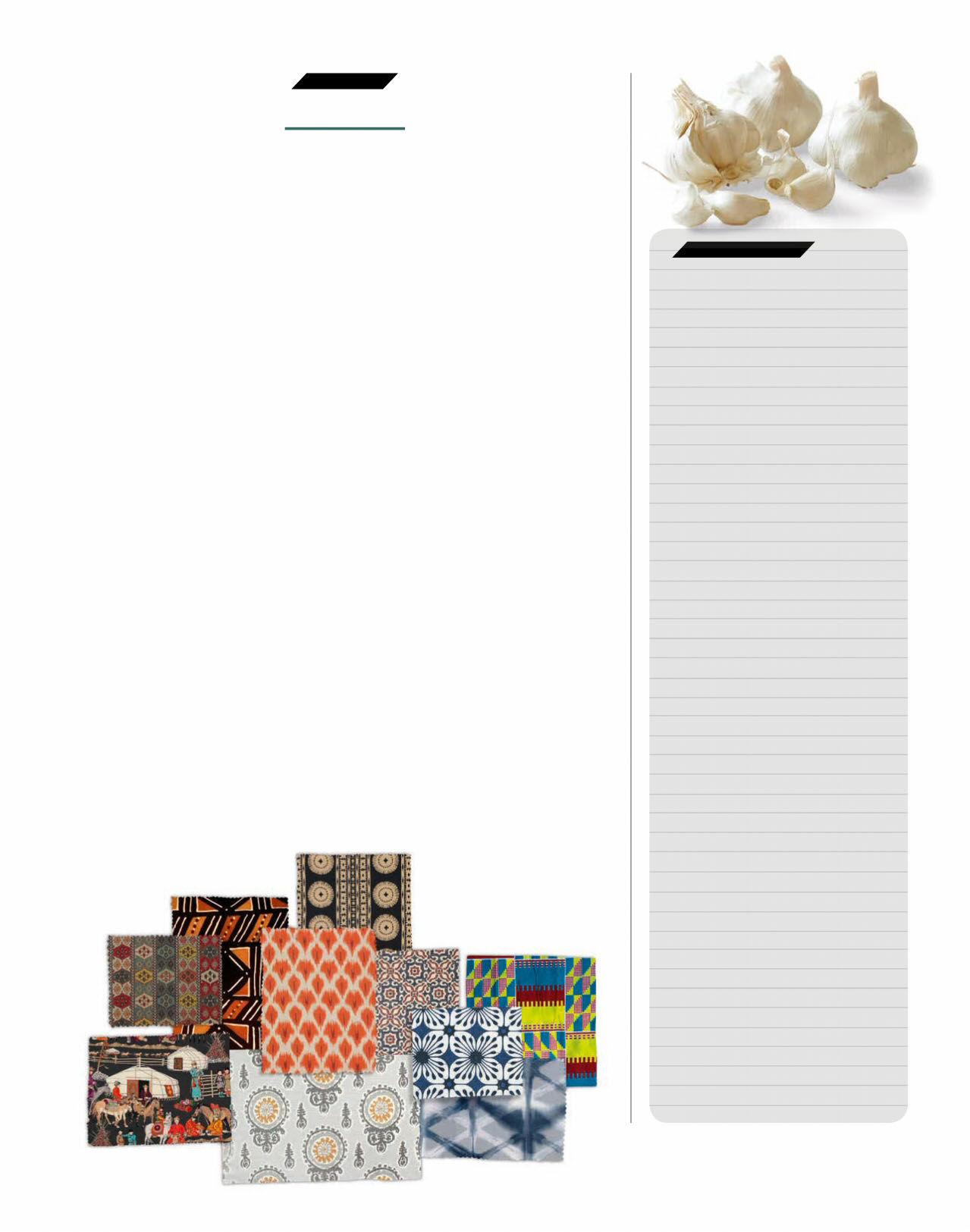
6 minute read
Ask An Expert Professional advice
from AHG - May 2016
ask an expert
H&G’s interiors guru Rose-Marie Hillier extols the virtues of transforming a room with tiles, then shares her favourites fabrics sourced from around the globe.
Advertisement
Q We want to update our kitchen and bathroom without doing a full renovation. We thought retiling with some fantastic new tiles would be a great, cost-efective way to refresh both rooms. Could you recommend some options?
Angie Frost, via email A he tile scene is very exciting right now and there are plenty of innovative styles to choose from. here’s a lot to love about the current market favourites: concrete- or timber-look porcelain tiles and encaustic tiles with graphic patterns. Emerging trends identiied at last year’s Cersaie, an annual tile and bathroom ittings exhibition held in Bologna, Italy, included brick-look tiles, chevron shapes, textured tiles in grey tones, cool blues and greens, super-sized tiles, 3D efects and street art/pop art-inluenced styles that add bright splashes of colour and movement. Another trend was tiles made from ‘fragments’; geometric shapes mixed to create a larger composition. here’s a big swing towards extending tiles from the kitchen splashback right up to the ceiling and full-height feature walls in bathrooms. here are plenty of suppliers to choose from. I like the handmade look of the ranges at Tiles of Ezra and Jatana Interiors; Di Lorenzo Tiles ofers an extensive collection of decorative tiles in various materials. > tilesofezra.com; jatanainteriors.com.au; www.dilorenzo.com.au.
W R I T E I N
Send your question, with your name and address, to Rose-Marie via H&G Advice, GPO Box 4088, Sydney, NSW 1028, or email h&g@bauer-media. com.au.
G L O B A L FA B R I C S
From north Africa to the Far East and all points in between, traditional cultures have a lot to of er textile designers in the way of inspiration. Here’s a sample of the appealing range of fabrics our worldwide search has uncovered.
Limit mud cloth (1) A traditional fabric from Mali, mud cloth is handwoven from cotton and dyed with earth- and plant-derived dyes. This pattern depicts ‘the necessity of limits in life’. $140/180x120cm, African Fabrics Collection; www.africanfabrics collection.com.au.
Flowers on Water Ikat cotton in Madder (2) Ikat is an extremely versatile print. This is a personal favourite because of the rich, warm colours. $79/m, No Chintz; www.nochintz.com.
Schumacher Bora Bora embellished linen in Lava Black (3) A unique interpretation of South Pacifi c textiles, this fabric features wooden beads embroidered into borders, contrast stitching and linen fringe. POA, Orient House; www.orienthouse.com.au.
Anthropology cotton in Watermelon (4) Inspired by the kilims of tribal central Asia, this fabric makes up into beautiful fl oor cushions and upholstery. $130/m, Warwick Fabrics; www.warwick.com.au.
Kente cloth in No 9 (5) This machine-printed cotton from Ghana is inspired by traditional Kente cloth. It features colourful geometric shapes in a basket-like pattern. $20/m, African Fabrics Collection.

Origami synthetic linen in Indigo (6) Featuring inky ‘perfect imperfections’, this fabric is a contemporary take on a traditional Japanese design. $113/m, Shibori; www.shibori.com.au.
Quadrille China Seas Barbados Batik linen-cotton in New Navy on White (7) China Seas is renowned for its beautiful batik fabrics, and this design would look especially appealing on sofas, cushions and curtains. POA, Ascrat ; www.ascrat .com.au.
Premier Prints Michelle Nova cotton in Birch (8) The colours allude to a Scandi palette but the infl uence is utterly Suzani with the printed ‘embroidery’ motif. POA, Online Fabric Store; www.onlinefabricstore.net.
Manuel Canovas Hazara cotton in Violine (9) A remarkable toile portraying daily life for Hazara people in northern Afghanistan and its surrounds. An interesting choice that works beautifully on curtains, cushions and bedhead upholstery. POA, Domus Textiles; www.domustextiles.com.au.
Pueblo polyester-acrylic in Navy (10) A large-scale Moroccan damask-style pattern is the hero in this gorgeous collection. $66/m, Warwick Fabrics. #
1 0 1
2 3
4 5
9 7
G A R D E N I N G Q & A
Q I’d like to grow my own garlic, since I learned that all imported garlic is treated with potent chemicals. Is it di cult?
Susan, Sydney, NSW A We should all be avoiding imported garlic, choosing Australian garlic every time. Garlic prefers cool climates but can be grown in most parts of Australia except the tropics, as it dislikes humidity and heavy rainfall. he key to success is in growing a variety that suits your particular location, climate and soil. Penny Woodward’s excellent book Garlic: An organic guide to knowing, growing and using garlic, from Australian Whites and Tasmanian Purples to Korean Reds and Shandongs($29.95, Hyland House), is the deinitive guide. It includes details of about 60 varieties grown here, and recommends Southern Glen, Glen Large and Italian Pink for Sydney. At garlicaustralia.asn.au, you’ll ind a list of members who sell direct to the public by mail order. he Diggers Club (www. diggers.com.au) also sells several varieties and has fact sheets on growing garlic. Plant garlic cloves into very well drained soil from autumn, and harvest mature bulbs in late spring to summer when the tops start to yellow and die down. In warm areas, chill bulbs in the fridge for two-three weeks before planting. It needs full sun, regular water and moderate fertiliser. Keep competitive weeds away as the plants grow. – Helen Young, gardening expert.

the green house scrap mettle
Television gardening guru Costa Georgiadis extols the virtues of responsible composting to Sarah Pickette.
If you think composting is simply a way to deal with kitchen scraps, Costa Georgiadis, the bearded host of ABC TV’s Gardening Australia, would like you to think again. “It’s much more than that,” he says. “Composting is a building block for sustainability, because it’s the one thing that every single one of us can do to help make a big diference to the amount of waste in our community.”
If you keep a small sealed bin in your kitchen to collect food waste for compost, you’ll soon notice that the garbage bin is nowhere near as full as usual, he says. “Take food scraps out of the waste stream, where they don’t belong, recycle just about everything else, and you’ll find it takes quite a while to fill a garbage bag.”
Costa, an ambassador for International Composting Awareness Week (May 2-8) , says not to let a lack of space stop you from composting. “You could choose a smaller system, like a Bokashi bucket, or investigate whether your council allows kitchen scraps in your green waste bin. If not, ask them why not.”
Composting is a lot easier than most people realise, says Costa. “There are some great compost systems on the market today that do all the work for you. So, for very little efort, you are diverting food waste from the anaerobic environment of landfill, where it produces methane, and you end up with a material that’s going to enrich your garden’s soil.”
Costa has a simple rule of thumb for getting your compost bin to work well. “For every quantity of fresh green kitchen waste you put in, you should add twice as much dry waste.” This dry waste could take the form of grass clippings, twigs or dry leaves, shredded newspaper or torn-up egg cartons. In an ideal world, you’d keep a container of dry material next to the compost bin, so it’s ready to add whenever you put in food scraps.
Let compost mature for an average of two to three months, depending on your climate, and you’ll end up with a wonderful soil conditioner. “Your garden will thank you no end,” says Costa. # For more information, go to www.compostweek.com.au.
Introducing the world’s most liveable carpet...
featured in
Find the Serenity Collection carpet you’ve been searching for at your local store or go to choicesflooring.com.au
o n l y a v a i l a b l e a t










